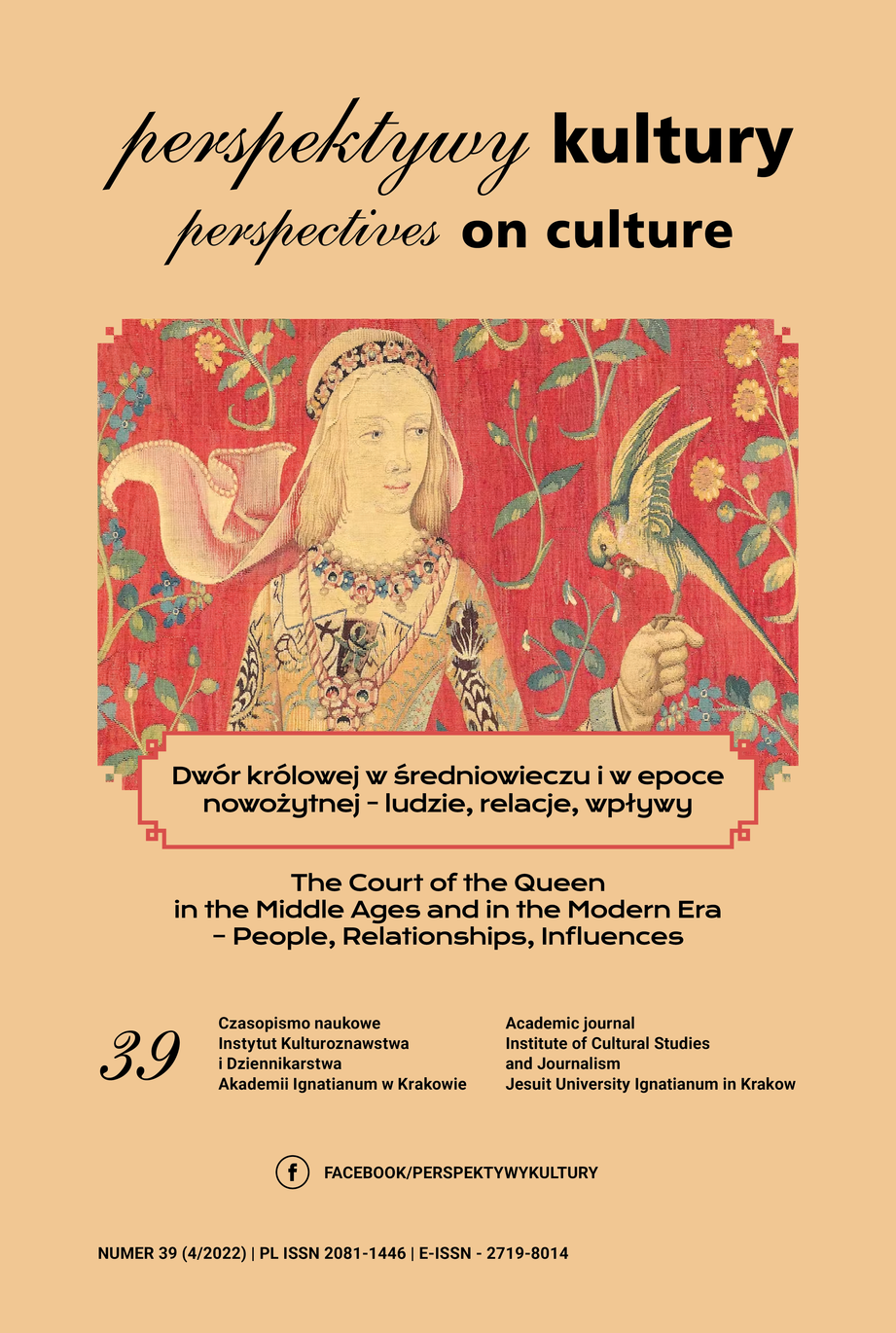Introduction
Abstrakt
The queen’s court was modeled on the king’s court and, as Marcin Kromer wrote in the 16th century, the ruler “feeds, clothes and remunerates” of all his wife’s courtiers (Kromer, 1984, 147), due to its role to merely serve its mistress, it could not be similar to the king’s court in terms of its role in the state. It seems that due to this disparity, the actual role of the queen’s court in politics, culture or the economy was mostly determined by her personality and ambitions on top of her relationship with her spouse, which increased or decreased her chances of making her court, or more precisely, the people associated with it, an important political factor. It is not surprising, therefore, that the attention of researchers was attracted to those Polish queens who stood out for their activity and influence on the state, for example, such as Queen Bona Sforza, while those who rarely or never went beyond the role of a royal consort remained in a deep shadow. Although it should be noted at once that there was an obvious change when the queen’s spouse also became the queen mother – the need to secure the fate of her children, especially sons, generally motivated Polish queens and those immediately surrounding them, making their courts and the people associated with them active participants in public life (SucheniGrabowska, 2009, pp. 247–260). However, these issues did not receive separate attention.
Bibliografia
Beem, Ch. (2020). Queenship in Early Modern Europe. London: Macmillan Education.
Bogucka, M. (1993). Kwestia kobieca okiem historyka. Teksty Drugie, 1993, 180–184.
Bogucka, M. (2000). New Perspectives on Gender. Acta Poloniae Historica, 82, 185–209.
Bogucka, M. (2004). Bona Sforza. Wrocław–Warszawa–Kraków: Zakład Narodowy imienia Ossolińskich. Wydawnictwo.
Bogucka, M. (2005). Gorsza płeć. Kobieta w dziejach Europy od antyku po wiek XXI. Warszawa: Wydawnictwo Trio.
Bogucka, M. (2009). The Court of Anna Jagiellon: Size, Structure and Function. Acta Poloniae Historica, 99, 91–105.
Bues, A. (2016). Art collections as dynastic tools: The Jagiellonian Princesses Katarzyna, Queen of Sweden, and Zofia, Duchess of Braunschweig-Wolfenbüttel. W: H. Watanabe-O’Kelly i A. Morton (red.), Queens Consort, Cultural Transfer and European Politics, c. 1500–1800. London: Routledge.
Czwojdrak, B. (2012). Zofia Holszańska. Studium o dworze i roli królowej w średniowiecznej Polsce. Warszawa: Wydawnictwo DiG.
Ferenc, M. (1998). Dwór Zygmunta Augusta. Organizacja i ludzie. Kraków: Towarzystwo Wydawnicze Historia Iagellonica.
Güttner-Sporzyński, D. (2021). Contextualising the marriage of Bona Sforza to Sigismund I of Poland: Maximilian I’s diplomacy in Italy and Central Europe. Folia Historica Cracoviensia, 27, 63–90.
Januszek-Sieradzka, A. (2017). Królowa Barbara Radziwiłłówna w dworskim mikroświecie. Lublin: Wydawnictwo KUL.
Januszek-Sieradzka, A. (2022). Queen Bona Sforza as Part of the Blended Family: Not Obvious Relationships at the Royal Court in Cracow. Opera Historica, 23, č. 1, 7–28.
Kosior, K. (2019). Becoming a Queen in Early Modern Europe. East and West. Basingstoke: Palgrave Macmillan.
Kromer, M. (1984). Polska czyli o położeniu, ludności, obyczajach, urzędach i sprawach publicznych Królestwa Polskiego księgi dwie, tłum. S. Kazikowski, wstęp i oprac. R. Marchwiński. Olsztyn: Pojezierze.
Kolankowski, L. (1913). Zygmunt August wielki książę Litwy do roku 1548. Lwów: Towarzystwo dla Popierania Nauki Polskiej.
Kuras, K. (2018). Dwór królowej Marii Leszczyńskiej. Ludzie, pieniądze, wpływy. Kraków: Wydawnictwo Historia Iagellonica.
López-Cordón, M.V. (2015). Los estudios históricos sobre las mujeres en la Edad Moderna: estado de la cuestión. Revista de Historiografía, 22, 147–181.
Marchwińska, A. (2008). Królewskie dwory żon Zygmunta Augusta. Organizacja i składy osobowe. Toruń: Wydawnictwo Naukowe Uniwersytetu Mikołaja Kopernika.
Niiranen, S. (2020). Continuing Family Bonds after Death: Catherine and Isabella. W: Á. Máté i T. Oborni (red.), Isabella Jagiellon, Queen of Hungary (1539–1559). Studies. Budapest: Research Centre for the Humanitie, 131–146.
Máté A. i Oborni T. (2020) (red.), Isabella Jagiellon, Queen of Hungary (1539– 1559). Studies. Budapest: Research Centre for the Humanitie
Pastrnak, P. (2018). Adducimus gemmam et florem: Bona Sforza’s bridal journey (1518) in the light of rituals and ceremonies. Studia z Dziejów Średniowiecza, 22, 174–193.
Pastrnak, P. (2020). Bona Sforza’s Bridal Journey to Poland as Imaginary Travelling and Jagiellonian Propaganda. Zeitschrift für Slavische Philologie, 76, is. 2, 289–315.
Pietrzak, J. (2018). Ceremoniał wjazdu w epoce nowożytnej na przykładzie podróży Teresy Kunegundy Sobieskiej do Brukseli na przełomie 1694 i 1695 roku. Scenariusz i interpretacja. Res Historica, 45, 87–120.
Pociecha, W. (1949). Królowa Bona (1495-1557). Czasy i ludzie Odrodzenia, t. 2. Poznań: Poznańskie Towarzystwo Przyjaciół Nauk.
Rutkowska, G. (2012). Dwór polskich królowych Anny Cylejskiej i Elżbiety Granowskiej. W: W. Bukowski i T. Jurek (red.), Narodziny Rzeczypospolitej. Studia z dziejów średniowiecza i czasów wczesnonowożytnych. Kraków: Towarzystwo Naukowe Societas Vistulana, 869–914.
Siwik, A. (2011). Kobieta w historii Polski. W: K. Slany, B. Kowalska i M. Ślusarczyk (red.), Kalejdoskop genderowy: w drodze do poznania płci społeczno-kulturowej w Polsce. Kraków: Wydawnictwo Uniwersytetu Jagiellońskiego, 17–41.
Skrzypietz, A. (red.) (2021). Queens within Networks of Family and Court Connections. Köln: Böhlau Verlag.
Sucheni-Grabowska, A. (2009). Królowe a następstwo tronu: Zofia, Bona i Maria Ludwika. W: A. Sucheni-Grabowska, Wolność i prawo w staropolskiej koncepcji państwa. Warszawa: Muzeum Historii Polski, 155–205.
Copyright (c) 2022 Akademia Ignatianum w Krakowie

Utwór dostępny jest na licencji Creative Commons Uznanie autorstwa – Bez utworów zależnych 4.0 Międzynarodowe.
Autor, zgłaszając swój artykuł, wyraża zgodę na korzystanie przez Wydawnictwo Uniwersystet Ignatianum z utworu na następujących polach eksploatacji:
- utrwalania utworu w formie papierowej, a także na nośniku cyfrowym lub magnetycznym;
- zwielokrotnienia utworu dowolną techniką, bez ograniczenia ilości wydań i liczby egzemplarzy;
- rozpowszechniania utworu i jego zwielokrotnionych egzemplarzy na jakimkolwiek nośniku, w tym wprowadzenia do obrotu, sprzedaży, użyczenia, najmu;
- wprowadzenia utworu do pamięci komputera;
- rozpowszechniania utworu w sieciach informatycznych, w tym w sieci Internet;
- publicznego wykonania, wystawienia, wyświetlenia, odtworzenia oraz nadawania i reemitowania, a także publicznego udostępniania utworu w taki sposób, aby każdy mógł mieć do niego dostęp w miejscu i czasie przez siebie wybranym.
Wydawca zobowiązuje się szanować osobiste prawa autorskie do utworu.





